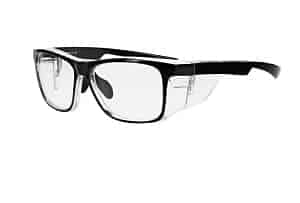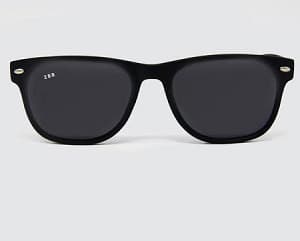As a near-sighted person, I find it not only extremely inconvenient but also uncomfortable to wear sunglasses. Have you ever experienced a similar discomfort? Good news is I’ve dug deep and found some pro tips on how to improve said experience. In this article, you will be guided step by step on how to wear sunglasses with glasses.
Table of Contents
What You Will Need
Imagine lying on a beach with the sun shining over your head, the sky is like a curtain of silk and the waves are like rollers of gem-blue dashing the sand, and you can see every detail crystal clear despite being near-sighted or far-sighted while protecting your eyes from the extreme UV. Let’s turn this into reality. Gather the following:
1. Prescription glasses
A good pair of prescription glasses can be a lifesaver to those experiencing vision problems. If you already own an ideal pair of prescription glasses, that’s great news and you can skip to number 2.
However, if you don’t have a pair or have ill experience with your current one, have your eyesight re-examined and purchase a new pair of glasses. Besides that, a good pair of glasses should have the right frames that compliment your face shape, fit your personal style and are the right size for your eyes. I will give more specific guidelines about the sizing of frames later in this article.
2. Sunglasses
There are many types of sunglasses for people with glasses on the market, and these are the three types I recommend:
- Prescription sunglasses: These are spectacles, the lenses of which have been made specifically to match the wearer’s vision defects. They are quite popular these days due to the all-in-one convenience. However, the maintenance cost might be high because you must have your eyes examined and get an updated pair every year or so. Also, you cannot change the styles regularly, and might find them boring and old-fashioned.
- Clip-on sunglasses: These are lenses that clip right onto your regular prescription glasses. They are less expensive than regular prescription sunglasses while allowing your eyes to be protected from the UV and comfortable. You can get all of that without having to remove your normal glasses. They are also portable and easy to bring along.
Sometimes, clip-on sunglasses might make people look unpolished and unstylish, but they are very practical to use.
- Fitover sunglasses: These are designed to be worn over the top of your prescription eyewear. It is a great option for those who find the other two methods too much to handle. Fitover sunglasses are very easy to bring along. When in need, just throw them over your regular glasses and you are good to go.
The most important part is that they are super light-weighted, trust me, you won’t even feel like you are wearing two pairs of glasses when they are on. Plus, others won’t ever notice your glasses underneath these elegant and sophisticated fitovers. The price is relatively affordable, too.
Steps to Wear Sunglasses Over Glasses
Wearing sunglasses for people with glasses might not be that difficult, but it’s a jungle out there! I curated the following part with a detailed explanation of each step you should take.
Step 1: Measure your perfect glasses’ width
This is when a mirror comes in handy. You should stand in front of a mirror and hold a ruler in line with your temple and measure the distance between your temples. Now, you have the total frame width of your wanted glasses. When choosing any pair of safety glasses, make sure the frames’ width is not wider than what you’ve measured.
Step 2: Choose the right frames
Choose the frames with a top that is lower than your eyebrows’ line. And the frames’ lower edge should never be pressed against your cheeks because they can cause irritation.
Step 3: Get the right lenses for your vision
Finding the perfect glasses might be a challenging process but we’re almost there. As I mentioned above, your lenses should always be up-to-date and improve your vision. A pair of prescription glasses that cause your eyes to water, become tired or irritated shortly after a few hours of use is not the right fit. The standard validity of a prescription is from 1 to 2 years depending on multiple variance, so take your time and get your eyes re-examined if necessary.
You should also keep a copy of the prescription from your optometrist in case you need to refer back to it in the future.
Step 4: Buy your flawless sunglasses
Here comes the most exciting part! Now that we have all of the measurements we need, we can go ahead and grab our flawless sunglasses. You can pick a modern, classic or vintage style, choose a color, and ensure that your lenses block 99% to 100% of UVA and UVB rays, like UV 400-protected sunglasses. But don’t forget to check these important factors:
- If you choose to buy prescription sunglasses, follow the 3 steps above to choose the ideal glasses’ width, frames, and lenses. Use the prescription you’ve got from the optical shop when it comes to finding the correct lenses.
- If you choose to buy clip-ons, the challenge is to find a pair of clip-on sunglasses over prescription glasses that fits properly. They must have the same or similar size and shape of your regular glasses, so keep an eye on the measurements we’ve made above.
- If you choose to buy fitovers, you should check that the sunglasses’ frames fit over your prescription glasses’ frames. So, keep the measurements we’ve made above in mind and select fitovers with slightly larger frames, while still making sure that the width stays the same as your regular glasses.
Step 5: Make necessary adjustments
Should you encounter a bit tight or loose frames, you can slightly bend the glasses’ temples or frame front to fit your face shape better. But don’t be afraid, once you follow the steps carefully, unfit glasses should not be a problem.
If you buy a pair of clip-on sunglasses, ensure that the clip is held tightly. Also, try walking, running or doing rotations on your feet. That way, you will know if you feel comfortable with the pair you’ve purchased.
Step 6: Try identifying objects or letters
Now that you are wearing sunglasses over glasses or your prescription sunglasses, try identifying small objects or letters around you to assure that you can see each and everything clearly. The sunglasses should not block your vision in any way.
Moreover, try looking at objects or letters at the corner of your left and right eyes, which are where the not-so-fit frames can block your vision.
Step 7: Make final assessment
The last step I recommend you to take is to make an assessment of your pair of sunglasses. Take note of the instances where you felt uncomfortable or blurry. By doing this, you can make adjustments for the best pair of sunglasses.
Our vision is extremely important as we carry out daily tasks, such as driving, reading, or even cleaning. Therefore, we must protect our eyes from the sun, while also remembering the importance of a good pair of prescription glasses, so that our eyes don’t have to overwork themselves. Keep the basic principles in mind so next time you wear sunglasses over glasses, you will be wearing them optimally.
Conclusion
Did you have fun following the tutorial? I, myself, definitely did. Wearing sunglasses over glasses should never be done carelessly at all. Emphasize each aspect to guarantee the maximum potential because at the end of the day, protecting our eyes is what matters the most.
I appreciate your attention and having you here. If you found this article helpful, please share it to the people around you so that those in need get the necessary help. Also, don’t forget to share your thoughts in the comment section. I can’t wait to hear from you!

Having worked in the field of personal protective equipment for over two decades, Andrew Carnegie is a specialist in the field.
At EDC, he strives to improve performance efficiency and promote workplace safety for EDC’s readers and customers. He also researches the most up-to-date equipment that has earned relevant accreditation for use in a wide range of industries and specialties.






